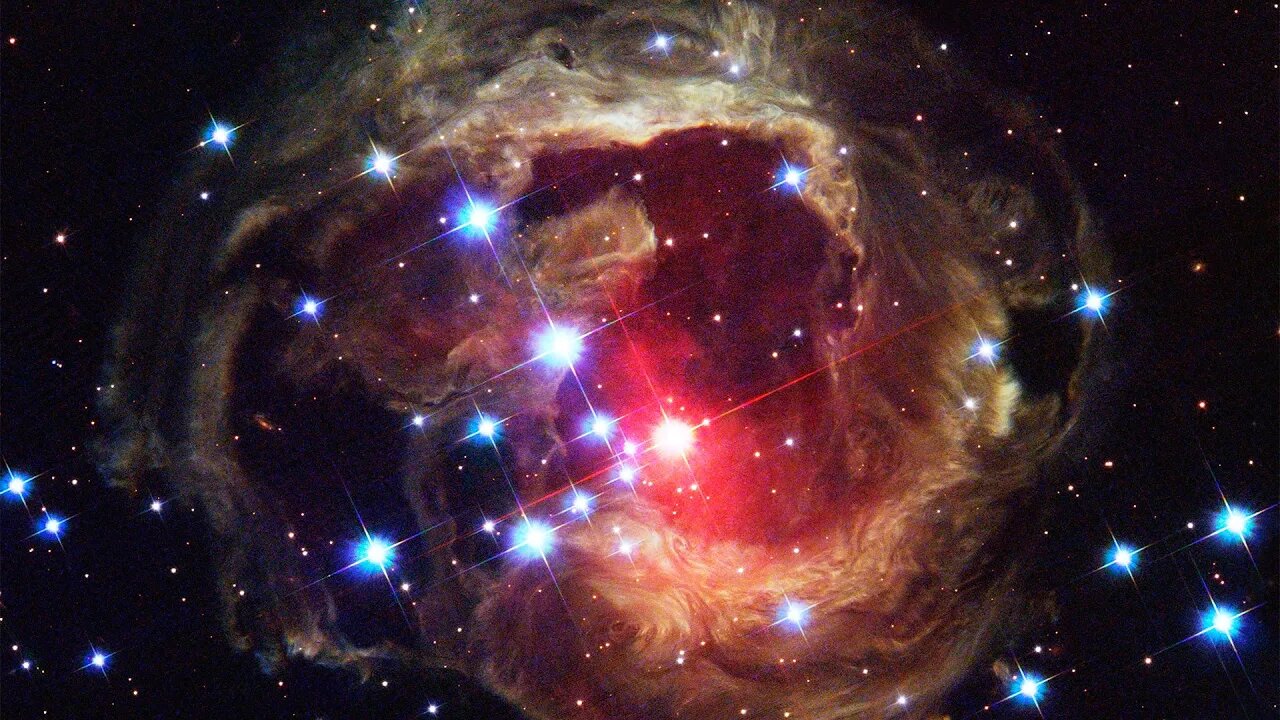Premium Only Content

Som ET - 23 - Stars - Hubble - V838 Mon
The Hubble Space Telescope's latest image of the star V838 Monocerotis (V838 Mon) reveals dramatic changes in the illumination of surrounding dusty cloud structures. The effect, called a light echo, has been unveiling never-before-seen dust patterns ever since the star suddenly brightened for several weeks in early 2002.
The illumination of interstellar dust comes from the red supergiant star at the middle of the image, which gave off a pulse of light three years ago, somewhat similar to setting off a flashbulb in a darkened room. The dust surrounding V838 Mon may have been ejected from the star during a previous explosion, similar to the 2002 event.
The echoing of light through space is similar to the echoing of sound through air. As light from the stellar explosion continues to propagate outwards, different parts of the surrounding dust are illuminated, just as a sound echo bounces off of objects near the source, and later, objects further from the source. Eventually, when light from the back side of the nebula begins to arrive, the light echo will give the illusion of contracting, and finally it will disappear.
V838 Mon is located about 20,000 light-years away from Earth in the direction of the constellation Monoceros, placing the star at the outer edge of our Milky Way galaxy. The Hubble telescope has imaged V838 Mon and its light echo several times since the star's outburst. Each time Hubble observes the event, different thin sections of the dust are seen as the pulse of illumination continues to expand away from the star at the speed of light, producing a constantly changing appearance. During the outburst event whose light reached Earth in 2002, the normally faint star suddenly brightened, becoming 600,000 times more luminous than our Sun.
Audio: Som ET - 23 - Stars
NASA Images:
https://stsci-opo.org/STScI-01EVT8CSM82MEDJW3RC0QD8ZSH.jpg
https://stsci-opo.org/STScI-01EVT8DAG0VC5KX9WS9Z5TV570.jpg
https://stsci-opo.org/STScI-01EVT8CKWZPARAH48QH5J440AN.jpg
https://stsci-opo.org/STScI-01EVVJY667Y9Z46CEGXZE9J5PN.jpg
https://stsci-opo.org/STScI-01EVVJXP3D04YJ1WAMQ3DQPH9D.jpg
https://stsci-opo.org/STScI-01EVT8D68JSFWTQ4YNKX3M9S3Q.jpg
Credits: NASA, ESA and H.E. Bond (STScI).
#NASA #jameswebb #Hubble #ESA #space #science #astronomy #universe #telescope #cosmos #galaxy #nebula #stars
-
 LIVE
LIVE
The Jimmy Dore Show
3 hours agoElon Goes SCORCHED EARTH on Budget Bill! Zionists Call Piers Morgan an Antisemite! w/ Youmna ElSayed
10,640 watching -
 LIVE
LIVE
Melonie Mac
2 hours agoGo Boom Live Ep 50!
268 watching -
 LIVE
LIVE
RiftTV/Slightly Offensive
2 hours agoBOMBSHELL: Jeffrey EPSTEIN Invested $170 Million in PALANTIR? | The Rift | Guest: Braeden Sorbo
686 watching -
 DVR
DVR
Playback Request Live
2 hours agoPRL: Pop-Punk Raised Us: Blink-182, Green Day & the Skatepark Soundtrack
3.41K2 -
 1:16:02
1:16:02
The Daily Signal
2 hours ago🚨 DEVELOPING: Biden Judge Blocks Deportation of Terrorist's Family
14.5K3 -
 LIVE
LIVE
Nina Infinity
4 hours agoWitcher 4 tech demo, Video Game Culture Shift? | BREAKING the NARRATIVE feat Hypnotic
199 watching -
 11:53
11:53
From The Desk Of Anthony Pompliano
3 hours ago $2.93 earnedThe Debt Spiral That’s Dividing Trump and Musk
15.5K4 -
 53:46
53:46
BonginoReport
5 hours agoThe Grift Is Real - Nightly Scroll w/ Hayley Caronia (Ep.62) - 06/04/2025
76.8K42 -
 1:11:55
1:11:55
Dr. Drew
7 hours agoMAHA Shock: FDA Approves New mRNA mNEXSPIKE Covid Vaccine From Moderna, Angering Voters w/ Dr. Simone Gold & Robert Suttle – Ask Dr. Drew
27.8K25 -
 45:26
45:26
THE Bitcoin Podcast with Walker America
3 hours ago $3.36 earnedIs Bitcoin Mass Adoption Finally HERE? Rockstar Dev in Las Vegas
18.5K3